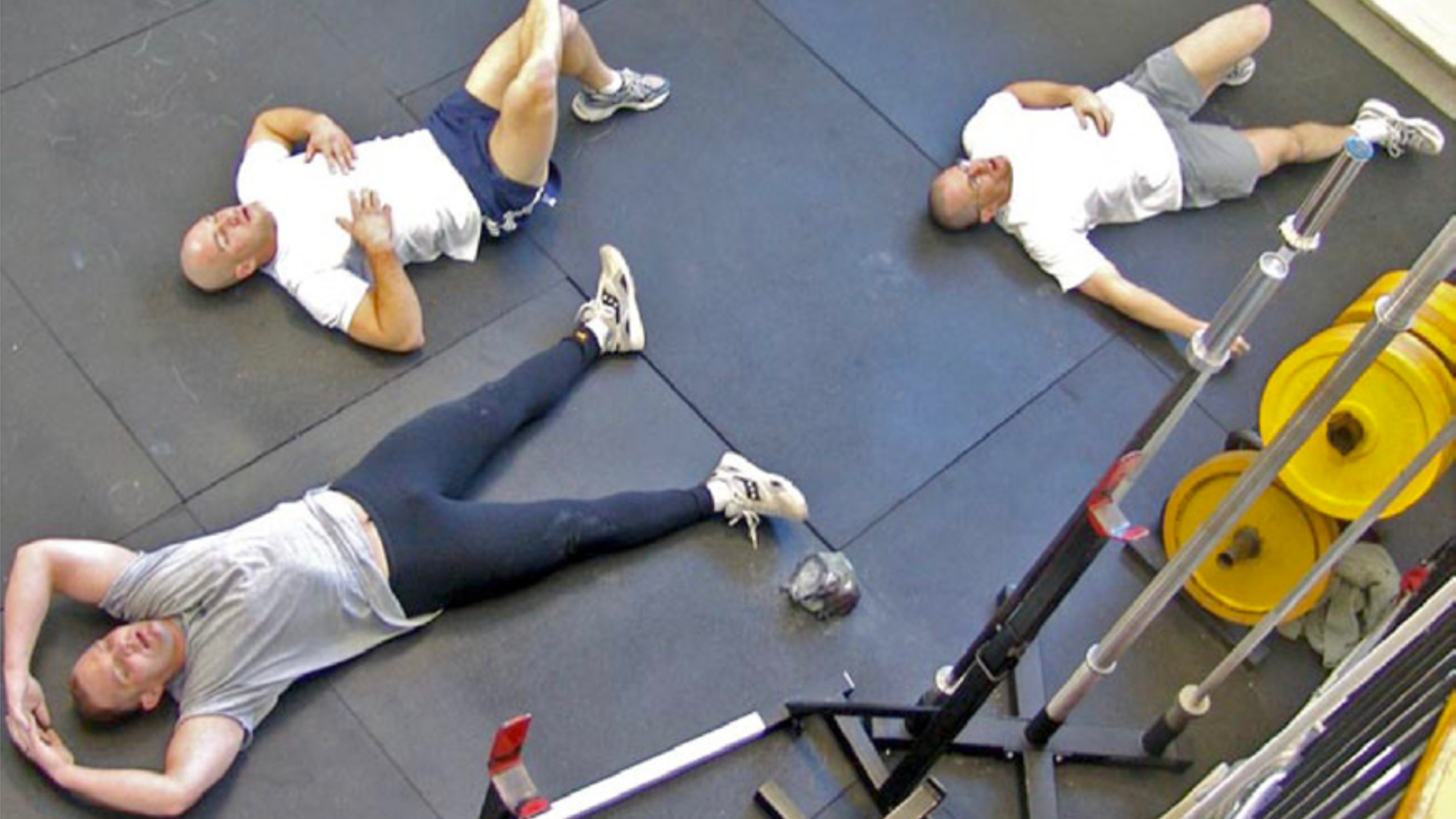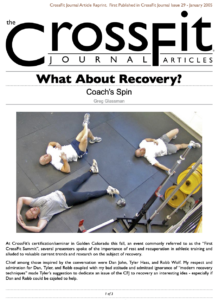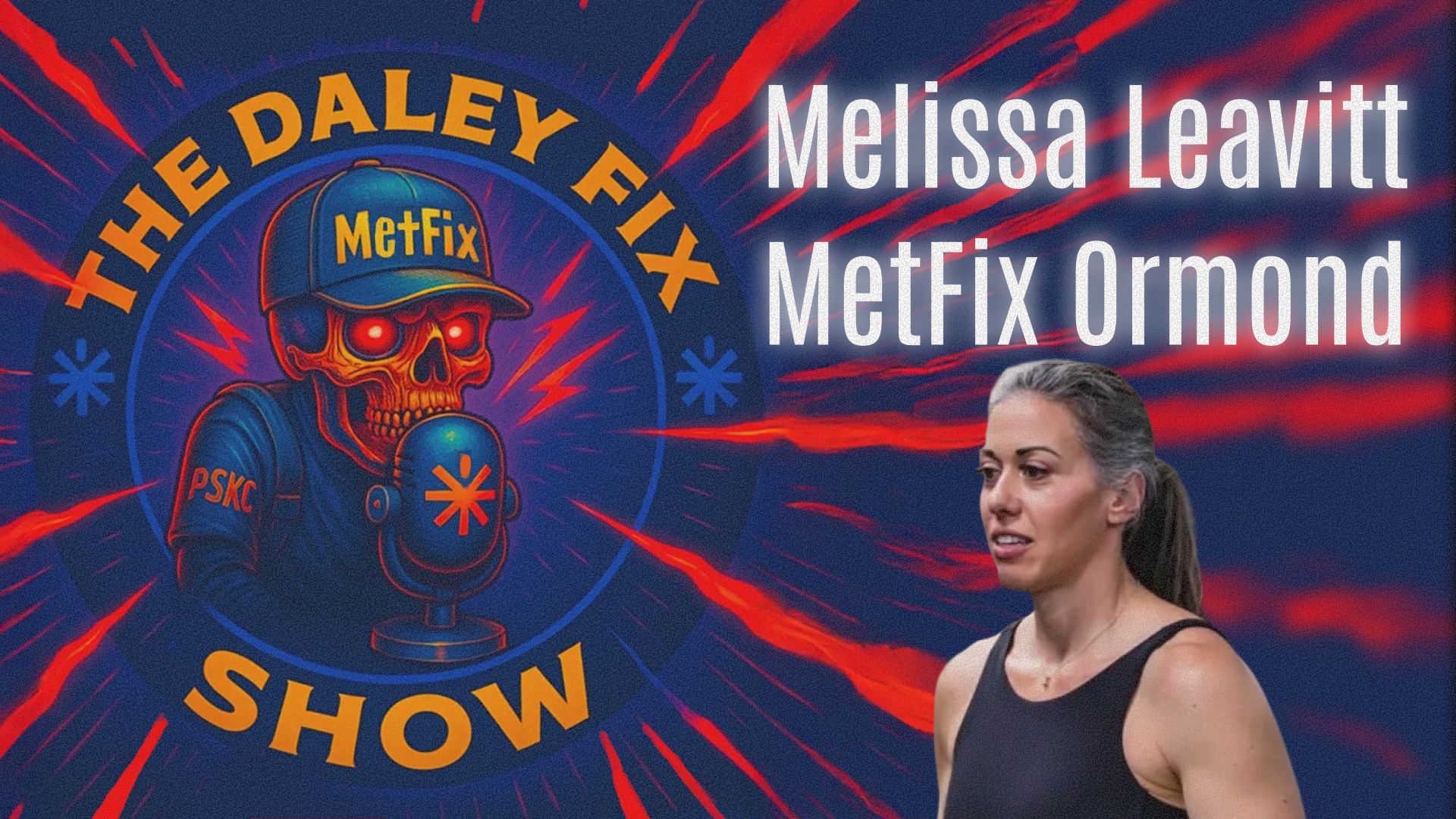By Greg Glassman
At CrossFit’s certification/seminar in Golden Colorado this fall, an event commonly referred to as the “First CrossFit Summit,” several presenters spoke of the importance of rest and recuperation in athletic training and alluded to valuable current trends and research on the subject of recovery.
Chief among those inspired by the conversation were Dan John, Tyler Hass and Robb Wolf. My respect and admiration for Dan, Tyler and Robb coupled with my bad attitude and admitted ignorance of “modern recovery techniques” made Tyler’s suggestion to dedicate an issue of the CFJ to recovery an interesting idea—especially if Dan and Robb could be cajoled to help.
For the record, my bad attitude towards any established corpus of recovery information stems from several quirks of my intellectual temperament and the nature of my clinical practice. It has been my professional experience that successful training protocols present themselves over time through superior performance among their adherents. Repeatedly over my career exceptional performance has been easily and quickly rooted out and attributed to the particulars of the performer’s training regimen. A natural process of question and answer mines more potent strategies quickly: “Where does this guy come from; he learns so quickly?” “He’s a gymnast.” “Why are these guys so much stronger than the others?” “They powerlifted for years.” “How did she get so lean so quickly?” “By cutting her intake of high glycemic carbohydrate.” By watching, learning, asking and experimenting we have been able to build a successful program whose methods were harvested entirely from elite performers. I want to ask someday, “Who are those amazing athletes?” to which the answer comes, “the new resters.”
Much of the talk about recuperative techniques centers on avoiding or curtailing “overtraining.” It is my considered opinion that overtraining is indicated by retrograde performance and specifically does not include symptoms mitigated or alleviated by additional sleep, fluids, massage or pampering alone.
I am waiting for a group, or even a single elite performer, to lay the fruit of his training on superior recovery techniques. If and when an athlete bests Greg Amundson or Josh Everett and differs from them largely in his penchant for cold beers, massage, ice baths or the company of pretty woman, we’re going to tinker, analyze and evaluate these predilections with ourselves and then with other athletes. I’m still waiting. I am personally hopeful that pampering and advanced recuperative techniques will make a substantial difference. Wouldn’t that be cool?
The reports this month don’t give me reason for encouragement. Stress control, massage, sleep, contrast hydrotherapy, hydration, recreation, stretching and chiropractic treatment top the list of promising recuperative techniques. While none of these are foreign to us, or even new to sport training, we’ve no evidence that they make measurable differences in accelerating the development of elite performance. I can appreciate the potential these modalities offer to comfort, but I’m not seeing the increased performance.
In spite of this curmudgeonly view of recuperative technologies I must add that our nutritional prescription may be lending its value via accelerated recovery. We know, through regular observation, that most fad dieters (low fat/high carb/low protein, chiefly) never stand a chance of surviving our protocol regardless of rest or ramping up. We’ve further noted that close adherence to our nutritional protocol by initially, at least, weighing and measuring food to establish accuracy and precision to the diet confers an advantage that less diligent compliance cannot match. The suspicion is that our nutritional strategy accelerates recovery, allowing for one or two more super-productive workouts each week. Over time this creates distinct athletic advantage.
It must be pointed out that while acknowledging that sleep deprivation, dehydration and inflexibility are detriments to performance I’ve seen no evidence that sleep, water or flexibility beyond “normal” levels help performance. Playing basketball in handcuffs will limit your game, but I’m not going to suggest that the removal of handcuffs is the key to increased basketball performance for all basketball players.
If we clump the recuperative modalities together as “pampering,” what my clinical practice suggests is that the pampered athletes are generally performing below the 50-percentile mark. Those most inclined, for instance, to yoga, meditation and chiropractic treatment are not our fire-breathers. I don’t think that yoga, meditation and chiropractic treatment are injurious to performance; I think that self-pampering and longing for comfort are, however, correlative with low drive and success. Why is it that those most inclined to worry and ask about “overtraining” are about as likely to set a new record in the Olympic Decathlon as they are to ever overtrain?
Much of the talk about recuperative techniques centers on avoiding or curtailing “overtraining.” It is my considered opinion that overtraining is indicated by retrograde performance and specifically does not include symptoms mitigated or alleviated by additional sleep, fluids, massage or pampering alone. Overtraining is not sleep deprivation, soreness or systemic or musculo-skeletal fatigue due to excessive training volume. Overtraining is a neuroendocrine beat down associated with excessively intensive work—more rest won’t necessarily help, reduced intensity will.
While insufficient recuperative techniques may be a factor in limiting training adaptation, it most clearly, obviously and certainly pales compared to the limitations inherent in not training hard enough. One powerful and obvious difference between the CrossFit approach to athletic strength and conditioning and other protocols is that we work harder, i.e., at higher intensity. There may be temptation to think that a program that advocates workouts lasting about 30 minutes offers more rest than those lasting several hours, but the problem with three-hour workouts is not that they leave two-and-one-half hours less recuperation time, but that they are not nearly intense enough to optimize adaptation.
Does my contention that undertraining is much the greater monster than overtraining imply that I think overtraining is rare or impossible? No, no, no and hell no, but I do believe that the biggest factor in overtraining is not under-recuperation but inadequate ramp up to higher intensity levels. Nowhere is this more apparent than with our Workout of the Day (WOD).
We have counseled in “Getting Started” and repeatedly elsewhere that the WOD is designed to exceed the capacities of the world’s fittest humans and that starting CrossFit by throwing yourself at the WOD 100 percent will result in devastating failure. We’ve recommended that anyone attempting CrossFit first get through a month of “going through the motions” before diving in with full intensity—“establish consistency before intensity.” Countless bad-asses from sporting and special operations communities, long regarded as bulletproof, have been burned at the stake of ego and intensity. More or better rest could not have helped.
Furthermore, though discomforting, counterproductive and generally ugly, overtraining is not the dread monster to be avoided at all costs as commonly portrayed. Overtraining is similar in disruption to a cold and never as severe as the flu. Show me an athlete who has never overtrained and I’ll show you someone far from his potential. It is actually very, very easy to make sure that you never overtrain, but optimal development comes on the margins of overtraining. That’s right, if you are far from overtrained, you are far from peak performance.
Everything that isn’t exercise is recuperation, but for me the benefits of off-time come not from enhancing athletic performance but from enhancing life. Exercise, fitness, sport and even health are only important in that they serve a broader purpose—life. We are made more alive by exercise and fitness, but reading, playing, studying and loving also make us more alive and enrich us greatly entirely independent of our physical well-being. I wholly recommend that you focus the 23.5 hours daily of non-exercise not on increased physical performance but on enriching your soul. If you should, however, find a path to athletic greatness that necessitates luxuriating, alcohol, massage and perhaps pretty women, send us the particulars and we’ll get busy resting. In the meantime we’re going to keep pushing for more work, done quicker, and getting on with the business of life in our off-time.
This article, by BSI’s co-founder, was originally published in The CrossFit Journal. While Greg Glassman no longer owns CrossFit Inc., his writings and ideas revolutionized the world of fitness, and are reproduced here.
Coach Glassman named his training methodology ‘CrossFit,’ which became a trademarked term owned by CrossFit Inc. In order to preserve his writings in their original form, references to ‘CrossFit’ remain in this article.
- Download Original PDF
- Download Español (Spanish) PDF
- Download Português (Portuguese) PDF
- Download Italiano (Italian) PDF
- Download Français (French) PDF
Greg Glassman founded CrossFit, a fitness revolution. Under Glassman’s leadership there were around 4 million CrossFitters, 300,000 CrossFit coaches and 15,000 physical locations, known as affiliates, where his prescribed methodology: constantly varied functional movements executed at high intensity, were practiced daily. CrossFit became known as the solution to the world’s greatest problem, chronic illness.
In 2002, he became the first person in exercise physiology to apply a scientific definition to the word fitness. As the son of an aerospace engineer, Glassman learned the principles of science at a young age. Through observations, experimentation, testing, and retesting, Glassman created a program that brought unprecedented results to his clients. He shared his methodology with the world through The CrossFit Journal and in-person seminars. Harvard Business School proclaimed that CrossFit was the world’s fastest growing business.
The business, which challenged conventional business models and financially upset the health and wellness industry, brought plenty of negative attention to Glassman and CrossFit. The company’s low carbohydrate nutrition prescription threatened the sugar industry and led to a series of lawsuits after a peer-reviewed journal falsified data claiming Glassman’s methodology caused injuries. A federal judge called it the biggest case of scientific misconduct and fraud she’d seen in all her years on the bench. After this experience Glassman developed a deep interest in the corruption of modern science for private interests. He launched CrossFit Health which mobilized 20,000 doctors who knew from their experiences with CrossFit that Glassman’s methodology prevented and cured chronic diseases. Glassman networked the doctors, exposed them to researchers in a variety of fields and encouraged them to work together and further support efforts to expose the problems in medicine and work together on preventative measures.
In 2020, Greg sold CrossFit and focused his attention on the broader issues in modern science. He’d learned from his experience in fitness that areas of study without definitions, without ways of measuring and replicating results are ripe for corruption and manipulation.
The Broken Science Initiative, aims to expose and equip anyone interested with the tools to protect themself from the ills of modern medicine and broken science at-large.
Support the Broken Science Initiative.
Subscribe today →
recent posts
Medical Society Webinar with David Wiss




